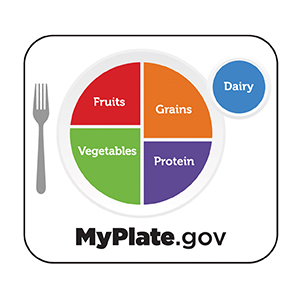Prepregnancy nutrition
Many women don't eat a well-balanced diet before pregnancy and may not have the proper nutritional status for the demands of pregnancy. Generally, a pregnant woman needs to add about 300 extra calories daily after the first trimester. This is to meet the needs of her body and her developing baby. But those calories, as well as her entire diet, need to be healthy, balanced, and nutritious. If planning a nutritious diet is hard for you, Ask your healthcare provider for a referral to a registered dietitian (RD) for help.
The MyPlate icon is a guideline to help you eat a healthy diet by encouraging a variety of foods while getting the right number of calories and fat. The USDA and the U.S. Department of Health and Human Services have prepared this food plate to help you select a variety of healthy foods. MyPlate is available for pregnant and breastfeeding women.
The MyPlate icon is divided into five food group categories:
-
Grains. Foods that are made from wheat, rice, oats, cornmeal, barley, or another cereal grain are grain products. Make at least half of your grains whole grains. Examples of whole grains include whole-wheat, brown rice, and oatmeal.
-
Vegetables. Vary your vegetables. Choose a variety of vegetables, including dark green, red, and orange vegetables, legumes (dry beans and peas), and starchy vegetables. Healthier choices include buying fresh, canned (low-sodium or no-salt-added versions), or plain frozen (without added sauces or seasonings) vegetables.
-
Fruits. Any fruit or 100% fruit juice counts as part of the fruit group. Fruits may be fresh, canned (packed in 100% juice or water), frozen, or dried and may be whole, cut up, or pureed. Eating fruit provides health benefits. People who eat more fruits and vegetables as part of an overall diet are likely to have less risk of some chronic diseases.These include heart disease, such as heart attack, stroke, and some cancers. Eating foods, such as fruits that are lower in calories instead of higher-calorie food, may be useful in helping to lower calorie intake. Fruits provide nutrients vital for health and maintenance of your body, such as fiber, vitamin C, potassium, and folate.
-
Dairy. Milk products and many foods made from milk are considered part of this food group. Use fat-free or low-fat dairy products that are high in calcium.
-
Protein. Go lean with protein. Choose low-fat or lean meats and poultry. Vary your protein routine by choosing more fish, nuts, seeds, peas, and beans.
Oils are not a food group, yet some, such as nut oils, fish, olives, and avocados, contain key nutrients and should be included in the diet in moderation. Others, such as saturated fats, are solid at room temperature and should not be included.
Exercise and everyday physical activity should also be included along with a healthy dietary plan.
To find more information see MyPlate.govand Dietary Guidelines for Americans. Please note that the MyPlate Plan is designed for people over age 1 who don't have chronic health conditions.

In addition to the MyPlate food groups, include the following nutrients in your preconception diet and continue into pregnancy:
Folic acid
All women of childbearing age need 400 micrograms (mcg) of folic acid each day. Pregnant women need 600 mcg of folic acid daily. Folic acid is a nutrient found in some green leafy vegetables, nuts, beans, citrus fruits, fortified breakfast cereals, and some vitamin supplements. It can help reduce the risk of birth defects of the brain and spinal cord. These are called neural tube defects. The most common neural tube defect is spina bifida, in which the vertebrae don't fuse together correctly. This causes the spinal cord to be exposed. This can lead to varying degrees of paralysis, incontinence, and, sometimes, intellectual disability.
Folic acid is most beneficial during the first 28 days after conception, when most neural tube defects occur. Unfortunately, many women don't realize they are pregnant before 28 days. This is why it's important to start folic acid before conception and continue through pregnancy. Your healthcare provider will recommend the right amount of folic acid to meet your needs.
Most healthcare providers will prescribe a prenatal supplement before conception, or shortly afterward, to make sure that all of your nutritional needs are met. However, a prenatal supplement doesn't replace a healthy diet.
Iron
Many women have low iron stores as a result of monthly menstruation and diets low in iron. Women over age 18 need 18 milligrams (mg) of iron daily. Iron needs increase during pregnancy. Building iron stores helps prepare a mother's body for the needs of the developing baby during pregnancy. Good sources of iron include the following:
-
Meats, such as beef, pork, lamb, liver, and other organ meats
-
Poultry, such as chicken, duck, and turkey (especially dark meat)
-
Fish and shellfish, including sardines, anchovies, clams, mussels, and oysters. Check with your healthcare provider before consuming other types of fish. Some may contain high levels of mercury.
-
Leafy greens of the cabbage family, such as broccoli, kale, turnip greens, and collards
-
Legumes, such as lima beans and green peas; dry beans and peas, such as pinto beans and black-eyed peas, and canned baked beans
-
Whole-grain breads and iron-enriched white bread, pasta, rice, and cereals.
Calcium
Preparing for pregnancy includes building healthy bones. If there is not enough calcium in the pregnancy diet, the developing baby may draw calcium from the mother's bones. This can put women at risk for osteoporosis later in life. The recommended calcium intake for women over the age of 18 is 1,000 mg daily. For women 18 years of age and younger, the recommended daily calcium intake is 1,300 mg. Three servings of milk or other dairy products each day equal about 1,000 mg of calcium.
Always talk with your healthcare provider about your diet and exercise needs.